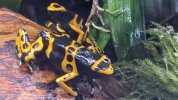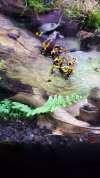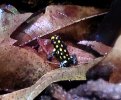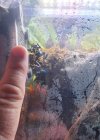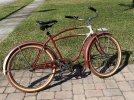GaryG64
Well-Known Member
- Joined
- Sep 8, 2022
- Messages
- 2,284
Other than trying to build models I have another hobby. I raise Poison Dart Frogs (PDF). These little amphibians have a lot of personality and can be comical at times.
I have 2 Dendrobates Leucomelas and one Ranitomeya Vanzolinii (his sibling died a few days after the tadpole stage into froglet).
There are many species in the rainforest and surrounding areas.
"You must be crazy to have an animal that is poisonous."
I hear that alot.
The Leucomelas, or leucs as they are commonly referred to in the hobby is toxic in its natural environment and derives its skin toxins from the ants in its diet. Dendrobatidae toxins vary from species to species, but some are extremely potent neurotoxins. The alkaloid toxins, secreted from the frogs' skin, interfere with nerve impulses, which can lead to heart failure or fibrillation.It is the only poison frog known to estivate during the dry season. Dendrobates leucomelas is one of the largest species in the genus Dendrobates, with a snout-to-vent length between 3.1 and 5 cm (1.2 and 2.0 in). Average adult size, however, rarely exceeds 4 cm (1.6 in).
The Vanzolinii or Vanzo is a small frog Adults of this species grow to between 16.7–19 mm (0.66–0.75 in) snout–vent length and feed on a variety of tiny invertebrates.
However, captive bred frogs are not poisonous if mine were reintroduced into their native area then yes, they would become toxic once more from their diet. In captivity they mainly eat various strains of fruit flies.
There is one frog listed as the most toxic invertebrate in the world. The Golden Dart Frog, in the wild, has enough toxins in a drop to kill two fully-grown elephants!
In the photos the yellow and black are Lucy and Bob. The spotted one is Tony (just random names that popped into my head one day.)
I have 2 Dendrobates Leucomelas and one Ranitomeya Vanzolinii (his sibling died a few days after the tadpole stage into froglet).
There are many species in the rainforest and surrounding areas.
"You must be crazy to have an animal that is poisonous."
I hear that alot.
The Leucomelas, or leucs as they are commonly referred to in the hobby is toxic in its natural environment and derives its skin toxins from the ants in its diet. Dendrobatidae toxins vary from species to species, but some are extremely potent neurotoxins. The alkaloid toxins, secreted from the frogs' skin, interfere with nerve impulses, which can lead to heart failure or fibrillation.It is the only poison frog known to estivate during the dry season. Dendrobates leucomelas is one of the largest species in the genus Dendrobates, with a snout-to-vent length between 3.1 and 5 cm (1.2 and 2.0 in). Average adult size, however, rarely exceeds 4 cm (1.6 in).
The Vanzolinii or Vanzo is a small frog Adults of this species grow to between 16.7–19 mm (0.66–0.75 in) snout–vent length and feed on a variety of tiny invertebrates.
However, captive bred frogs are not poisonous if mine were reintroduced into their native area then yes, they would become toxic once more from their diet. In captivity they mainly eat various strains of fruit flies.
There is one frog listed as the most toxic invertebrate in the world. The Golden Dart Frog, in the wild, has enough toxins in a drop to kill two fully-grown elephants!
In the photos the yellow and black are Lucy and Bob. The spotted one is Tony (just random names that popped into my head one day.)
Attachments
Last edited:

